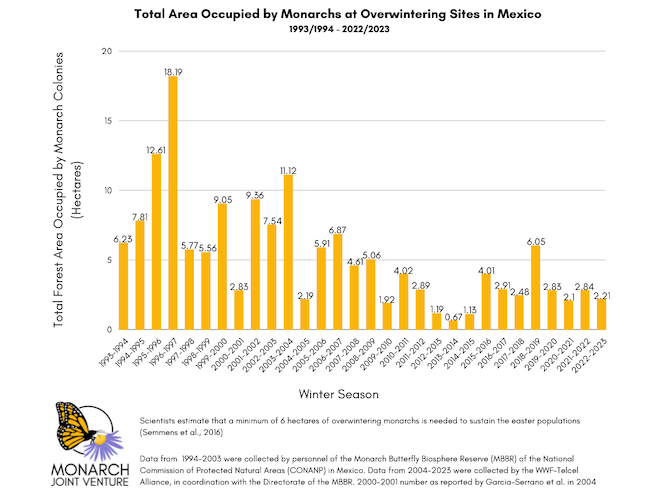The right habitat benefits both pollinators and upland birds
By Anna Swerczek
Eastern Monarch butterfly numbers at overwintering sites in Mexico are down 22 percent from a year ago.
The numbers come from an annual survey led by the World Wildlife Fund (WWF). Monarchs are too difficult to count individually, so researchers track the population based on how much space they inhabit collectively. This is measured in hectares — this year the monarchs have occupied 2.21 hectares.
These numbers continue a trend of long-term decline in monarchs that’s persisted for decades, due mostly to habitat loss.

It’s more important than ever to bolster monarch habitat, and one of the best ways to reinforce this vital cover is by planting milkweed and other pollinator mixtures.
Milkweed is a key host plant for monarch caterpillars. With over 100 different species across the United States, milkweed provides a tremendous food resource for monarchs nationwide. But it’s not the only thing they need. Nectar sources are an often-overlooked resource for monarchs but equally as important as host plants. Monarch migration covers thousands of miles and multiple generations, which requires an amazing amount of energy. They need nectar throughout their journey, and blooming wildflowers – spanning the entire growing season – are the best source for this nourishment. High diversity pollinator habitat, with a mixture of different wildflowers and host plants like milkweed, is key for the monarch population.
This habitat also benefits upland birds. Spring is just as important for pheasants and quail as it is for pollinators, and diverse pollinator habitat provides them with not only good nesting cover, but also excellent brood rearing cover. Chicks feed primarily on small, soft-bodied insects, and having a diverse wildflower bloom helps attract many of these bugs.
Pheasants Forever and Quail Forever understand the importance of this early successional habitat. Featuring over 250 field biologists across the U.S working on both public and private land, The Habitat Organization promotes monarch habitat and upland bird cover simultaneously. This diverse focus has allowed Pheasants Forever and Quail Forever to improve more than 230,000 acres of monarch and pollinator habitat in 2022 alone.
The organization’s Habitat Store also continues to develop high quality native seed mixes that provide nectar sources and milkweed throughout the growing season. Since 2015, the Habitat Store has helped plant nearly 320,000 acres containing milkweed, with over 1.17 billion total milkweed seeds planted.
Habitat Education programs are another important factor. The pollinator habitat outreach program and milkweed in the classroom program are both helping create the conservationists of tomorrow, and ensuring upland birds, pollinators and countless other wildlife species are here for generations to come. None of these programs and resources would be available without the support of our dedicated members, chapters, staff, and partners.
You can help save the monarchs by planting your own pollinator habitat or help support our mission by joining Pheasants Forever or Quail Forever today.
Anna Swerczek is Pheasants Forever and Quail Forever's Habitat Education Program Manager in Nebraska.